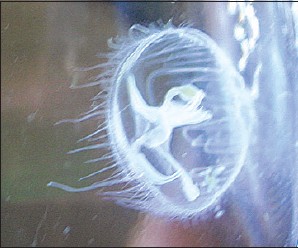On Sunday, September 4, Marco Manzo III was out for an early morning swim. Manzo, of Sagonto Resort, swims in Lake Saganaga often, so he was surprised, even perplexed, to see six jellyfish, two of which he caught.
Now Manzo has seen frogs and fish and minnows and tadpoles and otters and moose and ducks and loons swimming, even the moon swimming across the lake, but never jellyfish.
On Tuesday, September 6, Manzo took his dimesized translucent jewels to the Ontario Ministry of Natural Resources (MNR) in Thunder Bay and to the Minnesota Department of Natural Resources (DNR) office in Grand Marais. Area Fisheries Supervisor Steve Persons said that this is the first report of jellyfish in Saganaga Lake.
Since Manzo’s initial discovery on the Canadian side of Sag, he and his sister, Alesha Manzo, have found jellyfish on the U.S. side of the lake.
And where did these freshwater jellyfish come from? No one knows for sure, but Persons said other area lakes have them as well. In the past evidence has been primarily anecdotal. He had heard reports of the jellyfish in Banadad Lake, but said, “Frankly, I didn’t believe them.”
However, last year a specimen was brought in that had been found in Crab Lake.
It is believed that they are transported from lakes and ponds on the feet of water birds. They have no natural predators and eat small aquatic invertebrates and larvae, including mosquito larvae.
Researchers report that these freshwater jellyfish are harmless to humans but some people, small children and those with sensitive skin, may feel some mild irritation if stung, and people who have allergies to stings of any kind should not swim with them.
Their latin name is Craspedacusta sowerbyi but they are also called hydrazoans. Craspedacusta means “border guard” in reference to the stinging tentacles along the border of the body. They are the size of dime or a nickel. According to scientific literature, they will often appear for a few weeks to a few months, then disappear for 5-10 years. They are found throughout the world in tropical and temperate areas.
Are they a threat to the local fishery? Persons said no. “I think they are pretty benign,” he said. Benign perhaps, but very interesting.
As Manzo prepares for his next swim, one wonders what he might find. Will it be something small? Or nothing at all? Or will it be the Sag Lake monster? Stay tuned.




Loading Comments